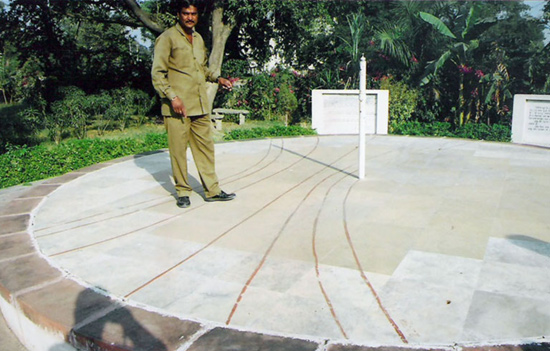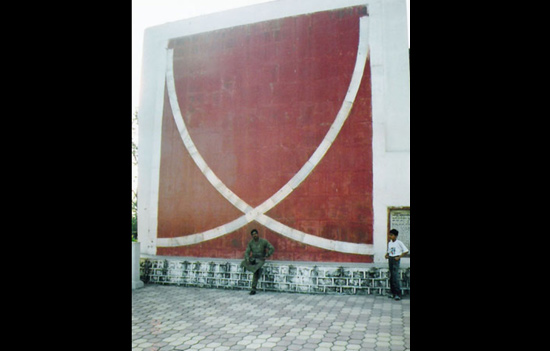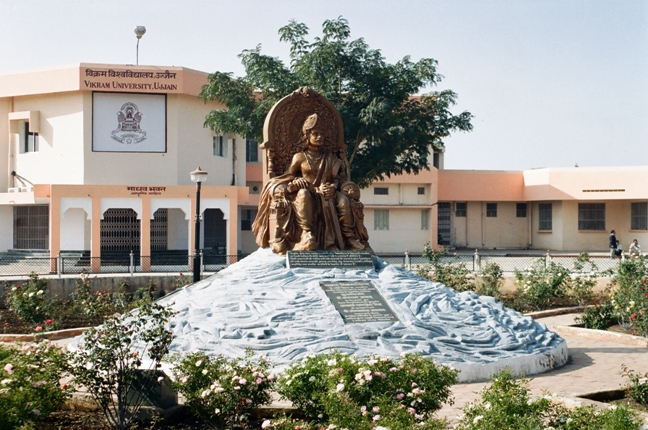Afterwards, I went on a trip to locate the zero degree meridian along with my sister. To my surprise, I learned
that the actual intersection of the meridian with the Tropic of Cancer was no
longer at Ujjain but at a place called Dongla, which was 30 km to the north of
Ujjain. The person who discovered this was the well-known archaeologist Dr Vishnu Sridhar Wakankar (1919–1988). I was familiar with his name. The famous Bhimbetka caves from the Paleolithic and Mesolithic periods which contain exquisite paintings were discovered by Dr V.S. Wakankar in 1957. As I learned more about Dr Wakankar’s work in the next two days, I felt even more amazed at his vast contributions.
The northward shift of the Tropic of Cancer has been caused by the Obliquity of the Earth’s axis as well as a phenomenon called Axial Precession. The axis of the Earth does not remain inclined at the same angle with respect to the ecliptic as it goes around the Sun. It’s tilt changes from 22.1 to 24.5 degrees and then comes back to 22.1 degrees. Right now it is 23.5 degrees.
In addition, the axis of the Earth itself rotates and
traces a circle. If you have seen a top wobbling, you will know what the
phenomenon of Axial Precession means. Hindu astronomers spent a great deal of
time observing and calculating that it would take about 27,000 years to
complete one precession cycle.
However, if one takes the whole cycle of Obliquity plus
Axial Precession which would bring back the Earth to the position where it
started then that cycle (now called Milankovitch Cycle) would take 41,000
years. The ancient Hindu texts are replete with references to the pole star and
constellations visible in the night sky, which have allowed astronomers to
calculate the year being referred to.
On the way to Dongla, the driver of my car stopped to talk to
his relative who was waiting for him on the side of the road. I was surprised
to find that the man knew all about the zero degree meridian of ancient times
and its shift to Dongla. He informed me that an observatory was being built at
the site.
Passing through beautiful fields, we finally reached
Dongla, where I could see a Vedhshala with a variety of traditional Indian
astronomical yantras on one side and several modern buildings on the other
side. A shaft-like structure jutted out of the landscape and I later learned
that it was a modern observatory equipped with a powerful telescope, which had
been installed by the government of Madhya Pradesh.
Shri Ghanshyam Ratnani ji, the caretaker of the
observatory showed us around. The great Dr V.S. Wakankar himself had taught him
the principles of astronomy! Ghanshyam ji took us up the steps of the structure
and we had a look at the telescope. He told us that many researchers came
periodically to use the telescope for their projects. The government is
planning to develop the site for tourism in the years to come.
From the second floor of the building, one could see the
village landscape all around. I learned that there was a planetarium as well as
auditorium. A school building stood a little distance away and I wondered if
the children there were familiar with the astronomical Yantras next door.
On a two-acre plot, the Wakankar family is maintaining the
yantras and also plans to build an experential centre. Ghanshyam ji took us to
each of the Yantras and explained how they worked. The first one we saw was the
Shanku.
 Shanku Yantra.
Shanku Yantra.
At that time I did not know what it was called in English but
later I learned it was the gnomon. The Shanku is just a vertical staff placed
over a horizontal surface. But it holds great importance in Indian astronomy
and just by observing its shadow, so many astronomical and geographical
readings can be determined such as the cardinal directions, time of the day,
latitude, longitude of the sun and so on. It is a crying shame that modern
schools do not teach children how to use the Shanku to build a fundamental
understanding of astronomy.
It was fascinating for me to learn about how Dr Wakankar
sent teams of people carrying a Shanku or gnomon (a basic but powerful
instrument used by Indian astronomers from ancient times) to find out where the
Karka Rekha (Tropic of Cancer) had shifted. At that time, Ghanshyam ji was just
a 15-year old assisting Dr Wakankar!
The second yantra at the Dongla Vedshala is the Bhaskar Yantra. A hollow rod passes through the centre of a sphere which is tilted at the same angle as the actual tilt of the earth. “If you see the sky through this rod then you will see the Pole Star,” informed Ghanshyam ji. Polaris or Dhruva is the pole star to which the North Pole of the Earth points today.
“It was at this spot that Dr Wakankar stood and said I found the place I have been searching for,” said Ghanshyam ji. “He always said that we should not have Greenwich Mean Time but Mahakaal Mean Time!” Recounting how the British moved the Prime Meridian to Greenwich, Ghanshyam ji said:
They moved the meridian there but they don’t even have more than a few hours of sunlight. And when their day changes at midnight, it is still dark for them while the Sun has already risen for us here.
Ghanshyam ji narrated a delightful story of how Krishna
and Sudama, in their student days had set out in search of the Karka Rekha.
They studied under Rishi Sandipani at his Ashram located in Ujjain. At that
time, Dongla was covered by jungles and not easily accessible therefore the duo
went to a place called Narayan Dham
which was at the same latitude but not on the zero degree meridian. At that
place, even today two Shankus can be found which are believed to have been used
by Krishna and Sudama. The story goes that the two were caught in heavy rain
and took shelter under a tree.
“Remember the story of Sudama eating chana and not sharing with Krishna,” said Ghanshyam ji. “That episode happened at the time.”
I smiled to myself as I saw the endearing manner in which Ghanshyam ji was juxtaposing scientific facts with delightful stories from the Puranas just as it has always been done in Bharat. Even when he scientifically explained the Earth’s rotation, revolution and precession which caused the change in seasons, his gratitude to Bhagwan for all these phenomena was palpable.
We also saw the Bhitti Yantra which is basically a wall
placed along the north-south meridian. Quadrants are inscribed on the wall with
markings of degrees and minutes. This yantra is used to measure the meridian
altitude or the zenith distance of an object such as the sun, moon or a planet,
which can then be used to prepare the Panchanga (Hindu almanac). The structure
looked very familiar because it can be seen in all the observatories built by
Sawai Raja Jai Singh at Delhi, Mathura, Banaras, Ujjain and Jaipur.

The Samrat Yantra is perhaps the most imposing of all the
Yantras. At Dongla it was a modest one but the one in Jantar Mantar at Jaipur
is the tallest at 90 feet. We were so engrossed in listening to Ghanshyam ji
that we did not click good photos. The two quadrant shaped walls projecting
from the two sides with a staircase at the centre (forming the hypotenuse) give
the feeling of being launched into the sky. As the Sun moves from the east to
the west, its shadow on the markings of the quadrants tell the local solar time
which we were told had to be corrected by 15 minutes to get the time referenced
to the Greenwich time.
Yet another sun dial at Dongla also gave the time in hours
and minutes with the help of the shadows cast by a gnomon. When I asked how the
time could be known in ancient times if the sun was covered with clouds,
Ghanshyam ji said that a sand clock was used in such situations.
Such has been the march of time that today, the grand
Samrat Yantra and sun dials of the world are all replaced by wrist watches and
electronic devices. I was lost in thought about the miniaturization of
instruments with the advance of time but Ghanshyam ji reminded me of the huge
environmental footprint that had come in the wake of all the progress in
technology. Our instruments have become compact but our energy and water
consumption have bloated beyond redemption.
One might wonder why we need the Yantras when we already have sophisticated astronomical instruments. I would argue that if students do not build their understanding of the universe on basic fundamentals by using the Yantras, their knowledge will be extremely superficial and incomplete. Let us say tomorrow we wake up to a world where all cooking is done only on induction stoves and microwave ovens, and people don’t know that fire can be used for cooking, would it not be a huge deficit in our understanding? Being so slavishly dependent on gadgets is taking away the connection with Nature. Should we not be trained to tell the time and season by looking at the skies and making basic measurements? After all, the movements of celestial bodies such as the Sun and Moon have direct impact on all the living beings on Earth.
A cruel twist that came in India’s history is that occupation by colonial powers downgraded its knowledge systems which had been transmitted for thousands of years through a variety of institutions such as Gurukulas, Mathas, Viharas, Ghatikas, Agraharas and Tols. In the period that the British occupied India first via the East India Company and then directly via the British monarchy, huge changes were made to the socio-economic structure of India. A policy of divide-and-rule which deepened the fault lines in society and the impoverishment of the people via draconian taxes and destruction of indigenous industry rendered a whole people powerless and voiceless. The imposition of English as a medium of instruction via the English Education Act in 1835 caused millions of Indians to be disconnected from their indigenous education systems.
In my two books on India’s educational heritage written in 2017 and 2021, I have made a strong case for recognising the knowledge that India gave to the world and for strengthening the civilizational roots of Indians today.
In 1884, when the International Meridian Conference was
held in Washington, D.C., with representatives from 25 nations, there was
obviously no representation from India because it was a colony of Britain. At
this conference, the meridian passing through the Royal Observatory in
Greenwich was voted as the Prime Meridian. Also, in 1905, the meridian passing
through the east of Allahabad (now Prayagraj) was chosen as the central
meridian of British India. John
Eliot, a meteorologist in the service of the occupying British government
of India and director-general of Indian observatories was asked by the Royal
Geographic Society to choose two time zones of 5 hours and 6 hours east of
Greenwich as the standard time zones of India. He decided to go for a single
time zone of 5 hours 30 minutes East of Greenwich Mean Time as the most
suitable from the British point of view. The British-operated railways had
informed him that they did not want the inconvenience of two time zones for
operating trains within the country. And thus, an arbitrary time zone was
chosen for India by the British regime.
 Inside Vikramaditya University, Ujjain.
Inside Vikramaditya University, Ujjain.
In the past decade there has been a great churning
amongst Indians who are discovering their true history which is free from colonial
bias. The government of India has been trying to include Indian Knowledge
Systems in education. In Ujjain, I found a keen desire among the educated
people to restore the status of their city as a hub of knowledge as it used to
be during the times of Emperor Vikramaditya. The Government of Madhya Pradesh
is actively promoting initiatives to showcase art, culture and heritage.
In a recent development, the newly appointed Chief
Minister of Madhya Pradesh Shri Mohan Yadav has asserted that Ujjain should once
again become the Global Prime Meridian, which has created quite a controversy
in the media.
Technically, it does not matter which meridian is used
as the zero degree meridian unlike the Equator which has astronomical
significance. However, the importance of Ujjain in the history of astronomical
observations cannot be ignored. While it is too impractical to expect the
global order to accept Ujjain as a prime meridian once again, perhaps the
Indian Standard Time meridian which currently passes through Mirzapur (82.5
degree East) in Uttar Pradesh can be changed to Ujjain (75.79 degrees East) in
Madhya Pradesh.
It will involve a great deal of administrative pain
however it will set our history right in a small way. At least, let us make the
Indian meridian pass through Ujjain as a sign of respect to all those
astronomers who built the foundation of astronomy and mathematics. More
importantly, as friend Raj Vedam says, Ujjain must be developed into a major hub
of astronomical research. Let the best astronomical minds meet again at Ujjain
as they did from the times of Varahamihira.
I would like to thank Dr Vedveer Arya, Dr
Raj Vedam and Shri Anil Narayanan for their critical inputs to this article.
Note: Today, the Greenwich Meridian has been replaced by
the IERS Reference Meridian,
which differs slightly from the historical Greenwich Meridian.
This article was first published here It has a few short videos which can be viewed by clicking on the link. Except where stated pics from esamskriti database.
Also
see albums of
1. Jantar
Mantar Observatory Ujjain
2. Jantar Mantar Jaipur
3. Read
Places to see in Ujjain